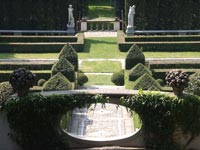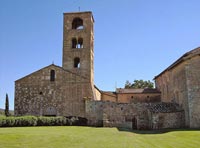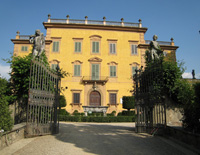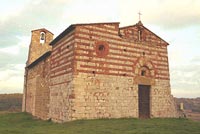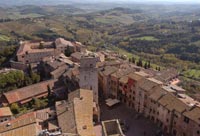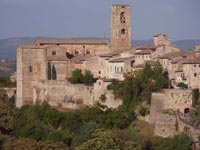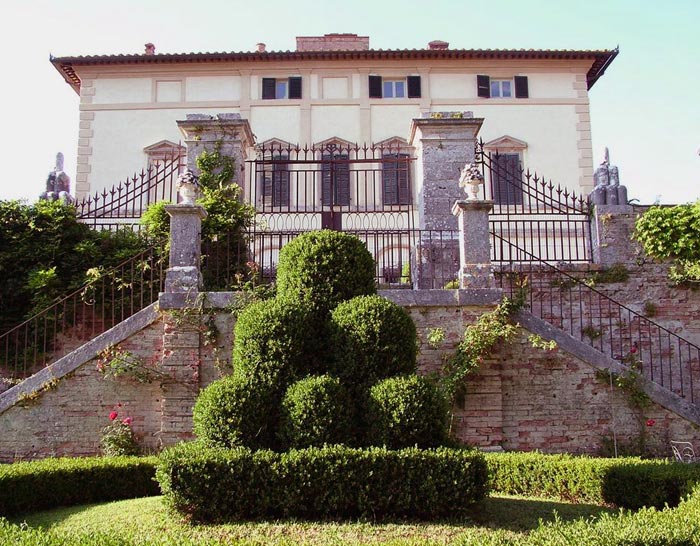 |
| Villa di Vicobello |
Villa di Vicobello |
Both villa and garden were built by the Chigi family in the 16th century. The project is generally attributed to Baldassare Peruzzi, the architecy of many villas and gardens in the treeytory of Siena. |
| Baldassare Peruzzi |
|||
Baldassare Peruzzi, the architecy of many villas and gardens in the treeytory of Siena. Almost all art critics ascribe also to him the design of the originally Villa Chigi, now Villa Farnesina, in Trastevere. His final architectural masterpiece, the Palazzo Massimo alle Colonne (1535) located on the modern day Corso Vittorio Emanuele, is well known for its curving facade, ingenious planning, and architecturally rich interior. Baldassare Tommaso Peruzzi (7 March 1481—6 January 1537) was an Italian architect and painter, born in a small town near Siena and died in Rome. He worked for many years, beginning in 1520, under Bramante, Raphael, and later Sangallo during the erection of the new St. Peter's. He returned to his native Siena after the Sack of Rome (1527) where he was employed as architect to the Republic and built new fortifications for the city. |
|||
| Villa Farnesina (Rome) is an artistically and architecturally influential Renaissance villa in Via della Lungara, in the central district of Trastevere in Rome. The villa was built for Agostino Chigi, a rich Sienese banker and the treasurer of Pope Julius II. Between 1506–1510, the Sienese artist and pupil of Bramante, Baldassarre Peruzzi, aided by Giuliano da Sangallo, designed and erected the villa. In the picture: the famous Loggia di Amore e Psiche, the vault frescoed by Raphael and Giulio Romano. |
|||
| Villa La Suverana in Casole d'Elsa |
|||
| The first records of the building date back to 1138, when it was the property of the powerful Longobard family, the Ardengheschi. In the mid-16th century, Pope Julius II (Giuliano della Rovere) received the villa as a gift from Pandolfo Petrucci, lord of the Republic of Siena. The pope ordered that what was then an austere fortress be transformed into a splendid Renaissance villa, surrounded by a large park, and the famous Sienese architect Baldassarre Peruzzi was commissioned to carry out the plan. Gardens in Tuscany | Villa La Suverana in Casole d'Elsa |
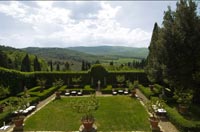 |
||
| The Chigi family, which later became Chigi Zondadari has very ancient origins. The first to figure in the genealogical tree was Rolando born in the year 1020. The Chigi family was raised to nobility under Lorenzo di Chigio who served on the Concistory in 1377, representing one of the Terzi or Thirds of the City. Towards the middle of the fifteenth century the Mariano di Agostino branch began to detach itself, predominating in importance since it was led by the patron of the arts Agostino di Mariano, known as “The Magnificent” on account of his exceptional wealth. He was the great banker of the Christian world, and was responsible for the construction of the Palazzo Farnesina in Rome. Among the properties of the Chigi family are the Villa di Vico Bello close to Siena and the Villa delle Volte, in Volte Basse close to Sovicille, set in the depths of the verdant peace of the Sienese countryside, and traditionally used by the family as a site for entertainment and repose. Another figure which brought renown to the Chigi family was Fabio di Flavio, who became Pope as Alexander VII. Born in Siena in 1599, he was a man of culture and an austere ascetic who had a brilliant ecclesiastic career. When he became Pope he transformed Rome with scenic grandiosity, employing the foremost artists of his time such as Maratta and Pietro da Cortona. But it was above all his felicitous collaboration with Gian Lorenzo Bernini which reached levels of sublimity: together, among other works, they created the Colonnade of St. Peter’s in Rome and the Chapel of the Madonna del Voto in Siena. The nephew of this illustrious churchman, Flavio Chigi, was later to become a Cardinal and a great protagonist of the cultural and artistic life of Rome. In spite of this he never forgot Siena and its surroundings. In San Quirico d'Orcia he commissioned from the architect Fontana the palazzo in the centre of the town, an outstanding example of impressive and refined architecture. He left his fortune to his sister Agnese, who was married to Ansano Zondadari, granting to their son, Bonaventura, the title of Marquis of San Quirico. It is to Bonaventura Chigi Zondadari, with the help of the architect Fontana, that we owe the embellishment of Villa di Cetinale, and the establishment of the ceramic manufacture of San Quirico d'Orcia. One of Bonaventura’s brothers, Marcantonio Zondadari, was the Grand Master of the order of the Knights of Malta, another brother Anton Felice, was a Cardinal, while Alexander was archbishop of Siena. The line continued through Bonaventura’s son, Ansano, and the latter’s son Giuseppe Flavio, all men of great culture and human worth, leading up to the birth in 1841 of Bonaventura, Marquis of San Quirico and Senator of the Realm, a great collector and academic. Bonaventura’s son Angiolo died in 1947, and it is his descendants who are now the partners of the RVA group, and owners of the properties managed by the company. The Villa di Vico Bello, with its terraced gardens, and the Vico Alto complex - which after a careful renovation carried out around 1975 has been divided into the flats comprising the Residence Vico Alto – are recorded in the documents of the Chigi family from as far back as before the birth of Pope Alexander VII; they have been handed down from generation to generation to reach the descendants of the family who are alive today. According to ancient legends, Siena was founded by Galli Senoni, or by Senius, son of Romulus, but historic evidence reveals the existence of an Etruscan village. During the Middle Ages the city grew in importance, the population increased and the urban centre expanded, making way for the residences of many feudal lords. Demographic growth and economic development also ushered in the growing conflict between the two political factions, the Guelph party allied with the Papacy and the Ghibelline with the Emperor. Fundamentally Ghibelline, Siena was in continual conflict with Florence which was, on the contrary, essentially Guelph. The constant warfare with Florence came to a dramatic head at the battle of Montaperti in 1260, when the Florentines suffered "the massacre and butchery that stained the waters of the Arbia red” as Dante recorded it. Nine years later, in the battle of Colle Val d'Elsa, the Sienese were defeated and the Ghibelline chiefs were banished from the city. The city passed into the hands of the Guelphs who put an end to the conflict with Florence and established a new form of government which endured at length and enabled the city to prosper, developing the appearance which was to remain unchanged over the centuries. In 1559 it came under the dominion of the Medici, and from this time on shared the history of the Grand-duchy of Tuscany, first under the Medici and later under the house of Lorraine. The loss of independence was the source of a decline which has nevertheless ensured the extraordinary preservation of the ancient appearance of the city. Siena is a mediaeval city which fosters the survival of its traditional events; while to visitors these might appear merely spectacular, they are instead experienced by the citizens themselves as moments of intense community life. Without doubt, the most famous of all, which attracts tens of thousands of people to the Piazza del Campo on 2 July and 16 August, is the Palio, an extraordinarily intense and ruthless horse race, frequently cruel, which continues to arouse the same levels of passionate exaltation and rancour as it has done down the centuries. Siena also boasts a prestigious position in the world of finance, thanks to the ancient institution of the Monte dei Paschi, the second oldest bank in Italy. It also has a fine university and is a treasure-house of Italian art, as well as being at the centre of the production area for the superb Sienese Chianti. |
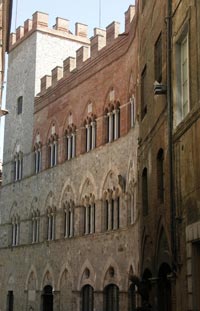 Palazzo Chigi-Saracini. Siena Palazzo Chigi-Saracini. Siena |
||
|
||||
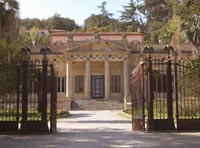 |
||||
Podere Santa Pia |
Podere Santa Pia, view from the garden on the valley below |
Villa San Martino, Napoleon’s summer residence | ||
Villa I Tatti |
Sovicille, Pieve di San Giovanni Battistaa Ponte allo Spino |
Villa La Pietra, near Florence |
||
Pieve of SS. Ippolito and Cassiano |
San Gimignano, view from Rocca di Montestaffoli |
Colle di Val d'Elsa |
||
|
||||



